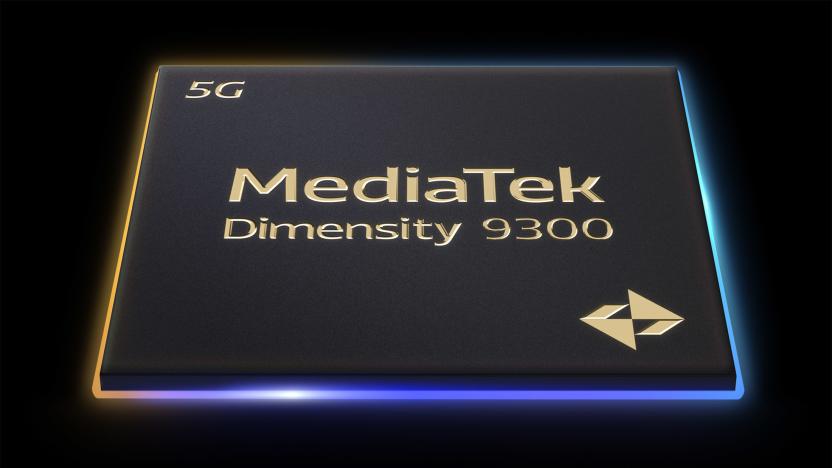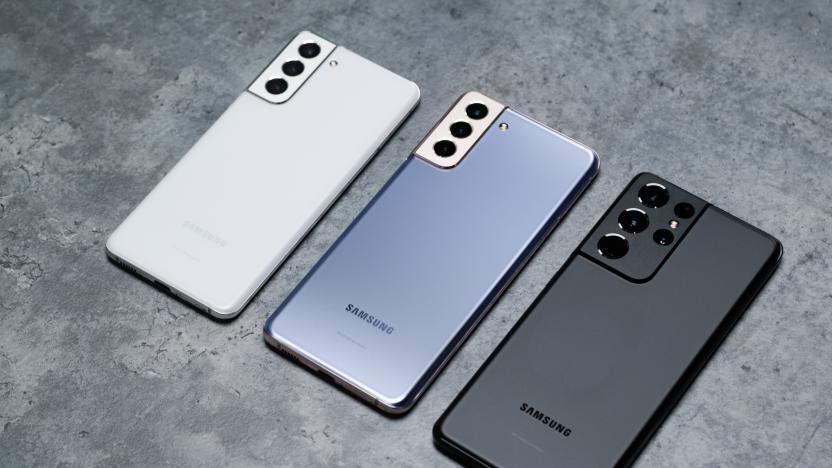system on chip
Latest

MediaTek takes on Qualcomm with its latest flagship mobile processor
MediaTek has unveiled its flagship Dimensity 9300 mobile processor using TSMC's 3rd-generation 4nm+ technoclogy.

Samsung's Exynos 2200 mobile processor uses an AMD ray tracing GPU
amsung has revealed the Exynos 2200, its first mobile processor with an AMD RDNA 2-powered GPU that will allow ray-tracing and other gaming features.

Google’s own mobile chip is called Tensor
Google's head of hardware Rick Osterloh explains how the company's first custom designed chip, Tensor, is all about AI.

AMD and Samsung are collaborating on Exynos mobile chips capable of ray-tracing
Samsung's next-gen Exynos chip will feature AMD graphics tech that cen deliver ray tracing.

Standalone scanner keeps your prints out of hackers hands
The ease with which hackers seem able to access password secured computer systems including airlines, major corporations -- even the White House -- it's little wonder that the security community is scrambling for alternatives. But even biometric locks that scan our irises, faces, and fingerprints can be broken if they're connected to a compromised computer. That's why Synaptics has developed a fully self-contained fingerprint scanner.

Broadcom's new chips could put fast LTE in your budget smartphone
While entry-level smartphones are getting to be quite good these days, few of them have fast LTE; many have to make do with either basic LTE or 3G. If Broadcom is successful with its just-revealed M320 and M340 system-on-chip designs, though, advanced 4G could soon be very affordable. The new chips respectively bundle dual- and quad-core processors with 150 Mbps LTE radios, making it easier for small firms to ship cheap handsets (Broadcom expects sub-$300 pricing) with speedy internet access. They're already integrated with Android 4.4 KitKat, too, so companies don't always have to fuss over software support. Broadcom isn't saying when phones with the new chips will reach the market, but it's currently delivering sample units to "leading" manufacturers.

First 64-bit quad-core ARM chips to be fabricated by... Intel?
Intel's largest chip manufacturing customer, Altera, has said that it'll soon be building chips there based on -- wait for it -- ARM technology. Its Stratix 10 SoC will contain a quad-core, 64-bit ARM Cortex-A53 CPU, which Intel confirmed would be the first of that type manufactured by anyone. By contrast, Apple's latest Samsung-built 64-bit A7 ARM chips used in the iPhone 5s are only dual-core. However, Altera's processors, which will be fab'ed with Intel's advanced 14nm tech are destined for networking equipment only and won't compete with the likes of Qualcomm and Samsung for smartphones. In any case, Intel's just a gun for hire with its biggest competitor's tech, so it would be unwise to draw any conclusions -- after all, the chip giant has its own Clover Trail to follow.

MediaTek unveils quad-core MT8125 processor for budget tablets
MediaTek told us to only expect its tablet-focused SoC in the summer, but it's clearly something of a keener: we're already looking at the part today. The new MT8125 builds on the familiar formula of a quad-core Cortex-A7 processor and PowerVR Series5XT graphics, with most of the improvement coming from a higher 1.5GHz clock speed. That extra grunt helps the chip handle up to a 1,920 x 1,200 display on top of earlier support for 13MP cameras and 1080p videos. Focusing on tablets gives MediaTek some freedom in configurations, too -- it can offer the SoC with basic EDGE cellular data, full HSPA+ or WiFi alone. Customers won't have to wait long to try the MT8125 when tablets like Lenovo's IdeaTab S6000 series should be using it now, although there's no word on how much of that hardware will reach the US.

Intel's Penwell mobile processor given a close inspection, stuffs a lot into a little space
If you're one of those who took the leap into a first wave of Intel-based smartphones like the RAZR i, you're likely the sort to wonder exactly what makes them tick. SemiAccurate certainly does: it just posted some previously inaccessible diagrams that help reveal how Medfield's system-on-a-chip heart, Penwell, is mapped out. As a die shot shows, the Atom core is seemingly the least important part of the design -- the PowerVR SGX 540 graphics, camera processing and input-output interfaces dominate the crowded silicon. Between this dense, all-in-one design and stacking up to 2GB of RAM directly on top, Penwell occupies about 17 percent less space than its Moorestown ancestor and helps explain why we're looking at Atom-powered phones instead of another round of MIDs. We wouldn't get too comfortable with the current generation, though, as Intel is gradually warming up 22-nanometer chips that could make Penwell seem old hat.

Marvell brings a gig to WiFi with new 802.11ac 4x4 system-on-chip
If you need data to flow more copiously than your current wireless connection will permit, Marvell has just announced a new WiFi product that might let you finally cut the cord. The Avastar 88W8864 802.11ac "4x4" SoC will permit WLAN products to stream data at up to 1.3Gbps using four antennas, over three times faster than the 802.11n standard used now. The system also sports a specialized transmission method called "beamforming," that "greatly improves link robustness and wireless performance," according to Marvell, enabling seamless HD streaming in traditionally difficult spots, for instance. The new tech will also let you stretch out your wireless range by at least six times, while increasing the battery life of any connected device, to boot. The company expects the new technology to start arriving to products like set-top boxes, access points and "carrier-grade" HD by mid next year -- so you may want to put that messy wire-routing project on permanent hold.

Intel details Clover Trail tablets: three weeks on standby, 10 hours of use, 'full' Windows 8 experience
You only have to look at the tidal wave of Ultrabooks to know that Intel design specifications can carry a lot of influence with manufacturers. That's why the chip-maker's claims about its latest reference tablet, built around a dual-core Atom Z2760 processor (aka "Clover Trail"), likely give us a broad hint of what to expect from devices like the forthcoming Lenovo Think Pad 2, ASUS Vivo Tab and Samsung ATIV Smart PC. In particular, Intel has shown us slides claiming that the dual-core 1.8GHz chip with Imagination SGX545 graphics will offer the "best Windows 8 experience" on a tablet with "compatibility and support for traditional apps and peripherals." And if you think that sounds like a subtle jibe at ARM-based tablets running Windows RT -- a version of the OS that doesn't even try to play nice with existing software -- then you could be right. To be fair though, the point of RT is to offer superior portability, and that's why Intel is also keen to emphasize that Clover Trail won't impact too heavily on your freedom of movement. Tablets should come in below 1.5 pounds (680 grams -- similar to the RT spec and much lighter than a Windows 8 Pro tablet) and 8.5mm in thickness, with built-in 3G, 4G and NFC. You shouldn't need to carry a charger either, since a new power management system promises a distinctly un-laptop-like three weeks on standby and a full day of "active use" -- defined as being at least 10 hours. Windows 8 tablets won't be like Windows 8 Pro machines, however, so don't go expecting USB 3.0, or a guarantee of 1080p visuals (most Clover Trail devices we've seen are 1,366 x 768) or souped-up security -- the Atom Z2760 is very much an evolved Medfield processor, with similar silicon and firmware, rather than a shrunken laptop chip. Needless to say, what really matters is how well manufacturers adopt this design and what price points they manage to hit. Intel says that at least 20 different Clover Trail tablets are already in the works, and early price tags seem to be around the $799 mark -- a hefty demand for sure, but perhaps one worth paying for those who need full-fledged Windows 8 and true portability at the same time. RT tablets, meanwhile, will have to come in much cheaper than that in order to be worthwhile.

Intel reveals Quad-Core, LTE-capable mobile chips are on the way
Intel's curious decision to shun the US and release Medfield-powered smartphones in India, China, Russia and the UK might be because of those countries' underdeveloped levels of LTE. Marketing chief Sumeet Syal told TechCrunch that its current-generation x86 system-on-chip won't support the standard, but a modem solution will arrive at the end of the year -- with production ramping up in 2013. He also let slip to the site that a replacement dual-core platform will arrive shortly, claiming they'll benefit from Intel's hyper threading know-how. Syal said that Santa Clara is "comfortable" with its progress just months after entering the smartphone space but declined to discuss numbers -- for which we'll have to wait for the Q3 earnings call in October to find out how well (or not) Intel's mobile ambitions are going.

Samsung spending $4 billion to renovate Austin chip factory
Premiership footballers will be weeping in envy at the way Samsung's been spending its cash this month. After splashing $822 million on a Korean R&D center, it's now chucking $4 billion to renovate its semiconductor factory in Austin, Texas. The cash will be used to increase production on system-on-chip products used in a wide variety of smartphones and tablets, presumably to cope with future demand. It's not clear if this investment is in addition to the $1 billion it was raising in January to add a new SOC and OLED line to the same facility, but it's certainly a good time to be living in Texas, right now.

Marvell PXA988, PXA986 chips support 3G for China, the world without reinventing the wheel (or phone)
Whenever we see a smartphone optimized for China Mobile's TD-SCDMA 3G, it usually represents one of two things: it's either a China-specific variant of a phone we already know, or it's a local-only model that's unlikely to ever travel abroad. Marvell has just unveiled a new mobile processor platform that could allow for a lot more globetrotting with those basic designs. The PXA988 is limited to China Mobile's technology for data, but its PXA986 doppelganger can fit the same slot to offer regular HSPA+ 3G without forcing phone makers back to the drawing board. Both run on a dual-core, 1.2GHz ARM Cortex-A9 at their heart -- nothing exciting in mid-2012, although they're well-enough equipped to capture 1080p video and tout extras like NFC. Only test samples exist today, but there's a chance we'll soon see phone designs that are just as much at home in Berlin as they are in Beijing.

Intel porting Jelly Bean to its Atom architecture, is in no hurry to tell you when it's done
Intel has revealed that it's working on bringing Jelly Bean to its low-power Atom architecture. In an email to PC World, company rep Suzy Greenberg confirmed the project was ongoing, but didn't offer a timeline as to when the latest flavor of Google's mobile OS would arrive on a device. It's the same story regarding when Ice Cream Sandwich would turn up on Medfield-powered devices like the San Diego and its brethren. The report also pours cold water on hopes for Clover Trail powered Android gear -- saying that it's pencilled in as a Windows 8-only platform.

Project Moonshot take two: HP's low-power Gemini servers let go of ARM's Calxeda for Intel's Centerton
Last we'd heard of HP's Project Moonshot, that effort to create low-energy servers was set to ride on the back of the Calxeda SoC. But for the rollout of its production-ready "Gemini" models, the company's changed tack, replacing the previously announced ARM chips for Intel's Centerton. Why the sudden swap? Well, it seems that new Atom processor delivers the same energy-sipping promise of its predecessor, while also adding 64-bit support, a broader software ecosystem, error correcting code memory and hardware virtualization. That's all well and good, but when you boil it down to layman's terms, HP's really just angling for the ultimate in efficiency and it plans to do that by providing these compact servers in "a [smaller] footprint" than currently available setups. The system's still not quite ready for primetime consumption, given its very recent public outing, however, demo units are in the pipeline, with a planned launch for the end of 2012. If this sort of back-end geekery gets your blood flowing, feel free to hit up the official presser after the break.

Newport Media claims tiniest, lowest-power 802.11n WiFi chip yet, smartphones get a little less thirsty
Cellular chipsets get all the love these days, but it's WiFi that's still the most ubiquitous -- and often the most consistent drain on the battery. Newport Media might have that last problem solved through its new NMC1000 chip. The part is billed as the lowest-power 802.11n wireless system-on-a-chip you'll find, and potentially a big help to smartphones and other devices that lean heavily on a wire-free existence. At just 2.5mm (0.1 inches) square, the equally record-setting size should also please device makers trying to squeeze wireless into an exceptionally tiny footprint. If you're as excited about the prospect of WiFi everywhere as Newport's Stock Photography Woman above appears to be, you can get more details below and expect full-scale production in the fall.

NVIDIA touts 30 Tegra 3 smartphones set for this year, teases next-gen Grey SoC with on-board LTE
We're nearly halfway through 2012, but for NVIDIA, it seems the best is yet to come. The company's GM, Mike Rayfield, announced today that 30 smartphones with Tegra 3 chips are now slated for availability this year, which is double the success that the company had with its Tegra 2 platform during 2011. Perhaps more interesting, Rayfield also let it be known that the Grey platform -- not due for arrival until next year -- will be the first of NVIDIA's system-on-chip designs to include a built-in LTE radio. Specifically, we can expect it to include the Icera 500, a next-gen LTE modem that's set to supersede both the Icera 410 and 450 designs. The Icera 500 will initially debut as a standalone unit, but will later be integrated into the Grey platform. All things considered, perhaps its 2013 that NVIDIA should be most excited about.

Qualcomm hires former AMD CTO, makes 'em pay for dropping mobile
Qualcomm is hiring AMD's former CTO Eric Demers to help the company produce a blockbuster mobile graphics chip. It needs the silicon for its big push for smartphone dominance (and tablets running Windows RT) in the face of strong competition from Imagination Technologies' Series 6 PowerVR and NVIDIA's Tegra 3. Demers' first job will be to merge Qualcomm's in-house Adreno team with ATI's Imageon mobile graphics chip team, which AMD flogged off for $65 million back in 2009 -- a move Sunnyvale is probably regretting now that it too is trying to get its hardware into mobile devices, unless it included a do-over clause in the sales contract.

ST-Ericsson to pass off application processor business to STM, cut 1,700 jobs
It's not every day that ST-Ericsson crosses our radar twice, but in addition to reportedly signing a deal with HTC for developing low-end handset chips, the company just announced its plans for a turnaround. The message? A heavier focus on SoCs for smartphones and tablets, along with a push for even more partnerships to develop those products. While that all sounds rosy, ST-Ericsson is also ceding its application processor business -- employees, R&D and all -- to STMicroelectronics. All told, between the loss of its application processor business and other reshuffling, the company expects to shed around 1,700 jobs -- and save about $320 million annually. Those bittersweet details and more await you in the press release after the break.









